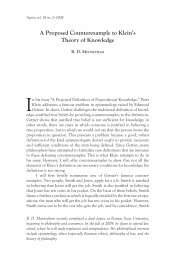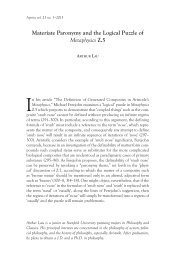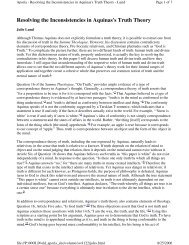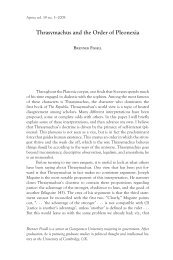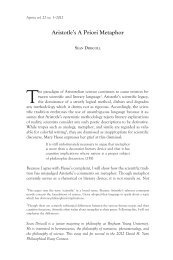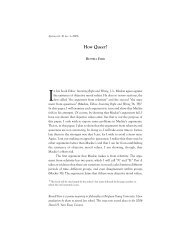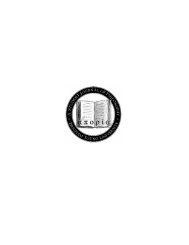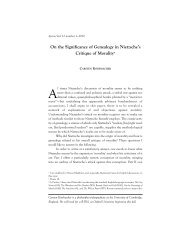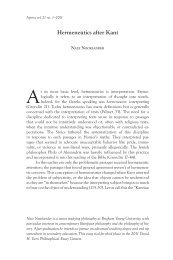Parmenides B6.1â2 without a Modal Fallacy - Aporia - Brigham ...
Parmenides B6.1â2 without a Modal Fallacy - Aporia - Brigham ...
Parmenides B6.1â2 without a Modal Fallacy - Aporia - Brigham ...
Create successful ePaper yourself
Turn your PDF publications into a flip-book with our unique Google optimized e-Paper software.
4<br />
Michael J. Hansen<br />
A, which can exist, is distinguished from B, which (poor<br />
thing) cannot: invalid, for to say ‘nothing cannot exist’<br />
is not to ascribe compulsory non-existence to anything<br />
but to say that it is necessarily (truistically) true that what<br />
doesn’t exist doesn’t exist, and this unexciting reformulation<br />
disables the argument. The fallacy is the so-called de<br />
re interpretation of modal statements. (94)<br />
Owen’s criticism is identical to the criticism of premise (3) given above: B<br />
cannot exist, but only in a de dicto formulation, not in a de re formulation,<br />
and for <strong>Parmenides</strong> to rule it out as an object of thought or speech requires<br />
the illegal de re statement.<br />
Owen gives two reasons to believe that “this celebrated fallacy is the<br />
point of the lines [B6.1–2]” (94). First, Owen believes this is the only translation<br />
that saves <strong>Parmenides</strong> from tautology, and the goddess clearly expects<br />
something more substantial than a tautology due to her injunction in<br />
B6.5, “that is what I bid you consider,” and due to her allusions to the first,<br />
wrong path in B2 (Kirk and Raven 270). Second, this translation fits nicely<br />
with the point of B3 (which establishes premise (1) above).<br />
Many scholars have followed Owen in ascribing this modal fallacy to<br />
<strong>Parmenides</strong>. 6 For example, Frank A. Lewis further presses the fallacy in his<br />
article, “<strong>Parmenides</strong>’ <strong>Modal</strong> <strong>Fallacy</strong>.” Lewis points out that in the poem, it<br />
appears that <strong>Parmenides</strong> presents some ways of inquiry and then argues by<br />
elimination for one of them: the way of is remains, while the ways of is not<br />
and of mixed (is and is not) fail. It is often supposed that mixed fails because<br />
of the law of excluded middle: if either is or is not, then the conjunct of the<br />
two (mixed) will be false. However, Lewis points out that this common reading<br />
of <strong>Parmenides</strong> fails to preserve this argumentative structure of elimination;<br />
<strong>Parmenides</strong>’ modal upgrades to is and is not (added in B2.3–6) make<br />
it impossible to eliminate mixed because of the law of excluded middle: “If<br />
the two ways are represented by their modalized upgrades, the disjunction<br />
of the two no longer makes an instance of the law of excluded middle” (2).<br />
The contingent, modal statements “is but can not be; and is not, but can be”<br />
are both still available, further ruining <strong>Parmenides</strong>’ argument by elimination<br />
(Lewis 2–3).<br />
Hence, instead of relying on the law of excluded middle to eliminate<br />
mixed, Lewis believes <strong>Parmenides</strong>’ denial of mixed relies on a modal fallacy<br />
that he calls an “illicit modal shift”: “‘necessarily (is → is)’ becomes<br />
‘is → necessarily is’” (5). This complaint is identical to the fallacy outlined<br />
6<br />
For example, in Philosophy Before Socrates, R. McKirahan quotes Owen on the modal fallacy and<br />
adds, “I assume that <strong>Parmenides</strong> was unaware of the fallacy” (164). However, McKirahan mistakenly<br />
cites Owen to substantiate his own claim that the argument “contains a subtle fallacy, treating<br />
‘nothing’ as if it could intelligibly, even if falsely, be said to exist” (164).



